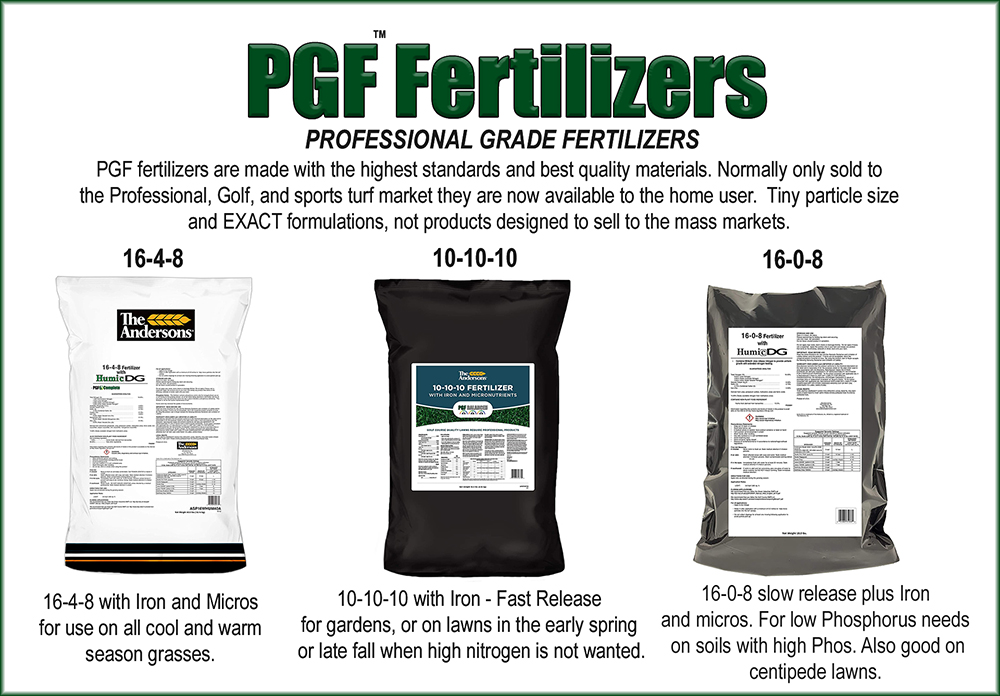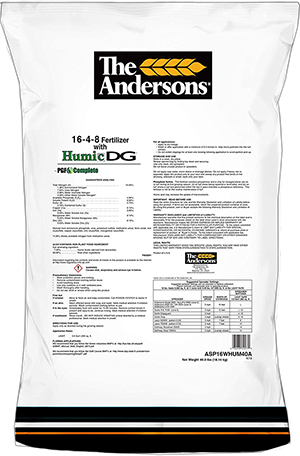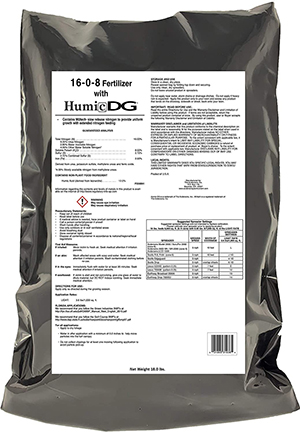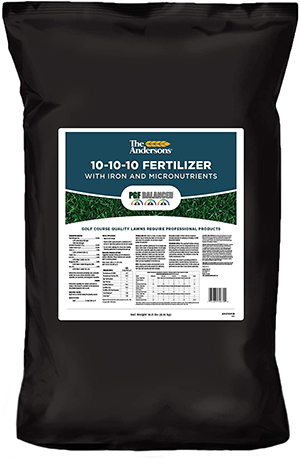The Perfect Fertilizer?
PGF Complete ™ is the perfect fertilizer because it’s mild, slow release (except for BALANCE), has TINY particles for good distribution, and can be applied every 3 weeks during the growing season. This is NOT a BIG BOX fertilizer. PGF stands for Professional Grade Fertilizer because it’s exactly that. Formally sold to the PRO, golf, and sports industry, PGF is now available to the average home owner.
DON’T rely on BIG BOX store brands to provide the TOTAL nutrition that PGF Complete ™ does. Products sold in these stores limit the nutrients so that misguided LOCAL LAWS don’t restrict their sales. PGF COMPLETE has everything your lawn needs and the results… will shock you.
PGF Complete 16-4-8 Click Bag for Price
Unless a SOIL TEST shows you need a nutrient adjustment, the majority of experts and university studies say the same thing. Apply a 4-1-2 ratio fertilizer for the best results during the ACTIVE GROWING SEASON. PGF Complete is a 4-1-2 ratio (16-4-8) It’s also high in Iron and other micro nutrients. The results are FAST and expect a rich GREEN lawn in 6-14 days after proper irrigation. For use on ALL warm and cool season lawns. Bermuda, Zoysia, Fescue, KBG, etc.
Available in 18 or 40 lb bags.
.
PGF Complete 16-0-8 Low Phosphorus
Click bag for price
PGF 16-0-8 contains no phosphorus. It is designed for lawns that do not need phosphorus or soils that are HIGH already in phosphorus. Also has Iron and micro nutrients. Also good for centipede lawns which do not like high phos.
.
PGF BALANCE 10-10-10
Click bag for price
PGF Balanced is a PRO GRADE, quick release, 10-10-10 with TINY particle size. Most 10-10-10 fertilizers look like large rocks and the distribution is poor. PGF Balance gives you 3 times the coverage.
Use in all gardens during the growing season.
Use on landscapes, trees and shrubs.
Use on lawns during periods when high nitrogen is not needed.

For All Lawns and Turf – Warm and Cool Season Lawns
Slow Release Fertilizer – Totally Complete – All in One – Professional Grade
Noticeable results in as few as 5 days with irrigation / watering / rains.
Everything in One Bag…
PGF (Professional Grade Fertilizer) takes all the research, top products, needed nutrients, and combines them into one bag. Doc has spent the last year testing and working with the Andersons plant nutrient group to develop an ALL IN ONE complete, professional grade fertilizer, and make it available to the average homeowner. Now YOU… can use the same quality products that are used on golf courses and sports turf around the world.
It’s Fast AND Slow…
If water is applied daily… you will see noticeable results in as few as 5 days. However, due to the varying forms of nitrogen, the release is slow and lasts for weeks.
What’s Inside…
- Super fine particles which give you TWICE the number of particles per square foot. More particles, better and more even distribution.
- 16-4-8 (4-1-2 ratio) of Nitrogen – Phosphorous – Potassium. This is the #1 recommended ratio for most lawns.
- Humic DG (humic and fulvic acid) which helps enrich your soil and allows plants to process nutrients better.
- 3% iron. Get that SUPER dark green lawn in DAYS.
- Micro nutrients.
Application Rate…
One 18 lb bag covers 5000 sq ft of lawn. Great for ALL seasons, spring, summer and fall. Apply every 6-8 weeks during the growing season. For summer application on cool season grasses apply at a 75 – 50% rate.
Types of Grass…
All lawns can benefit from PGF. Warm season and cool season lawns. Bermuda, Fescue, Centipede, Zoysia, St Augustine, etc. When applying on centipede lawns, apply at 1/2 the normal rate. So one bag will cover 10,000 sq ft.
More about the nutrients…
Best Fertilizer N-P-K Ratio
Without a soil test the consensus of most experts is very clear… a balanced NPK ratio of 4-1-2 is the best fertilizer for all lawns. Yes, you will hear arguments in many ways, but the experts (and our testing) has shown that this ratio is best overall ration for a regular maintenance fertilizer.
In most cases, a rate of one pound of nitrogen per 1,000 square feet is suggested for each fertilizer application to the lawn. If high percentage nitrogen fertilizers are used, then less actual fertilizer product is needed to supply that one pound compared to fertilizers with low percent nitrogen. Recommended ratios of N-P-K for lawn fertilizers include 3:1:2 or 4:1:2 → Link to Citation
Good maintenance type fertilizers should be in a 3-1-2 ratio of nitrogen (N) to phosphorus (P) to potassium (K). An example of a 3-1-2 ratio fertilizer would be a 15-5-10 or something relatively close to this. → Link to Citation
If you have not had a soil test, apply a fertilizer that is four to six parts nitrogen, one part phosphorus and two to four parts potassium. A 16-4-8 fertilizer analysis would fall within this range with a 4-1-2 ratio of these nutrients. → Link to Citation
Use a 3-1-2 or 4-1-2 ratio fertilizer if you elect not to conduct a soil test. A common example of a 3-1-2 ratio fertilizer is 15-5-10,while a good 4-1-2 ratio fertilizer is 16-4-8.These ratios generally supply what most lawns need, and they won’t dramatically increase the phosphorus levels if it’s unneeded → Link to Citation
Humic Acid (Humic DG)
Humic acid is a natural soil conditioner that acts as an organic chelator and microbial stimulator. It has a unique carbon matrix which includes a high concentration of trace minerals and organic acids. Humic acid enhances the plant’s ability to take in essential nutrients and improves soil structure. Proven Humic Acid Benefits:
-
- Increases soil carbon
- Improves plant health
- Improves germination and viability of seeds
- Chelates macro and micro nutrients to increase availability to the plant for a longer period of time
- Increases cation exchange capacity (CEC)
- Improves soil structure for better aeration and water movement
- Stimulates beneficial microorganisms, which can improve long-term soil pH
- Especially effective on sandy soils
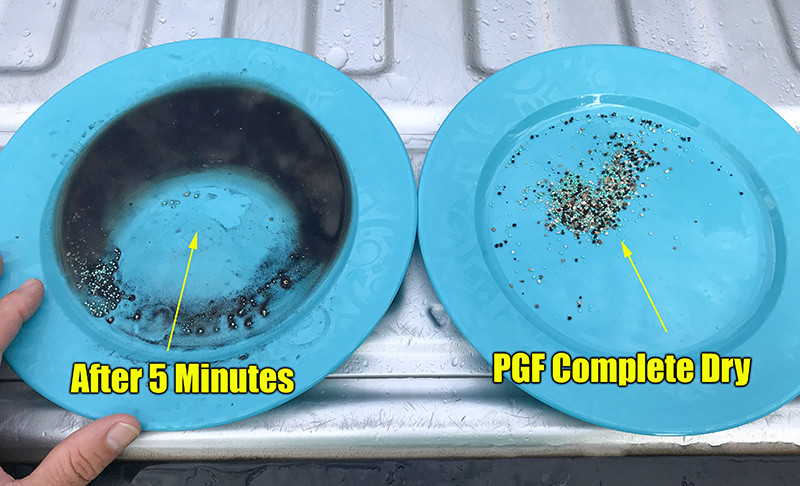
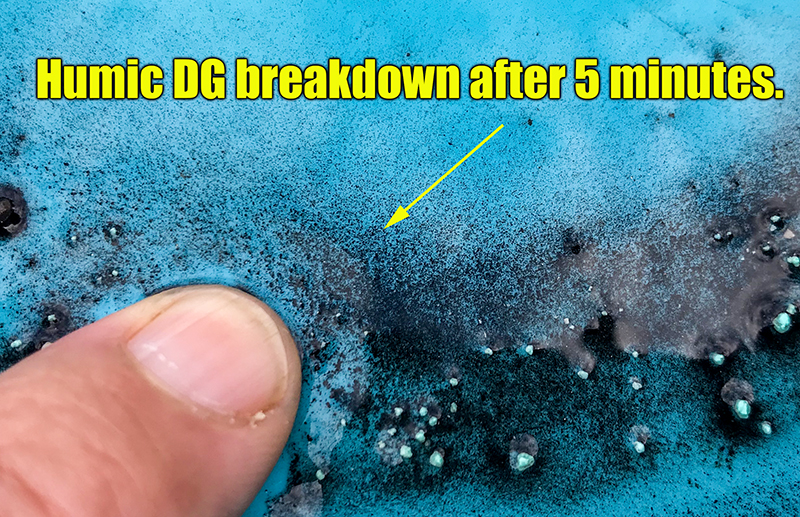
Iron…
Under normal turfgrass-growing conditions, it is common to observe a color response in turfgrass after an iron application, especially if the turfgrass is growing on a soil of neutral or alkaline pH. For the most part, turfgrasses are sensitive to iron levels and an application of iron, either to the soil or foliarly, generally imparts a darker green color to the turfgrass. Due to this response, iron is perhaps the most frequently applied micronutrient for turf-grasses. Although iron is not an actual component of the chlorophyll molecule (the green photosynthetic pigment of plants), it is an essential element that plants need to make chlorophyll. That is why iron levels affect foliage color.
The role of iron in turf nutrition Researchers have conducted many studies involving the function and necessity of iron in plants. It turns out that iron is an elusive element, and researching a plant’s requirement and making recommendations for iron is difficult. After many years of research, scientists still have not identified the exact roles of iron in plants. Although we know that iron is involved in chlorophyll synthesis and is a component of other plant tissues, questions remain concerning other roles it plays in plants. Further, attempts to correlate tissue-iron status with growth and color responses have not always revealed an obvious relationship. For this reason, few laboratories analyze soils and tissue for iron content. Lacking a strong correlation between soil- and tissue-iron content and turfgrass growth, it is difficult to make meaningful recommendations.
Turfgrasses differ in their sensitivity to iron deficiency. Generally, warm-season turfgrasses are more sensitive to iron deficiencies than cool-season turfgrasses. Differences also exist among the warm-season grasses. Centipedegrass, bahiagrass and bermudagrass tend to be more sensitive to iron levels than St. Augustinegrass and zoysiagrass. This is one reason why bahiagrass and centipedegrass usually grow better on acidic soils where iron is more available, whereas St. Augustinegrass is recommended for neutral and alkaline soils where iron is less available.
Micro Nutrients
Understanding the role of each micronutrient within the plant should provide a greater understanding of the key role these nutrients play in proper turfgrass management. Micronutrients are just as essential for proper turfgrass health as macronutrients, but are required in very small quantities compared with macronutrients. Micronutrients include iron (Fe), manganese (Mn), boron (B), copper (Cu), zinc (Zn), molybdenum (Mo), and chlorine (Cl).
- Iron: Part of the catalytic enzymes, Fe is required for chlorophyll synthesis affecting photosynthesis, nitrogen fixation, and respiration.
- Manganese: Involved in photosynthesis, Mn is required as a cofactor for about 35 enzymes. Lignin biosynthesis depends on Mn.
- Copper: Cu-protein plastocyanin is involved in photosynthesis and is a cofactor for a variety of oxidative enzymes.
- Zinc: Zn is a structural component of enzymes and is required for protein synthesis. Carbohydrate metabolism is affected by Zn
PGF Lawn Fertilizer is a COMPLETE and balanced professional grade product.
Particle Size
More particles per square foot gives PGF Complete some of the best UNIFORM performance of any fertilizer on the market.
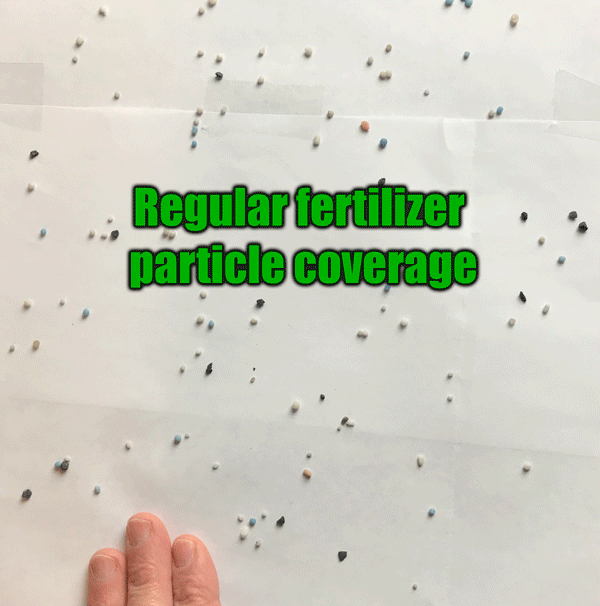
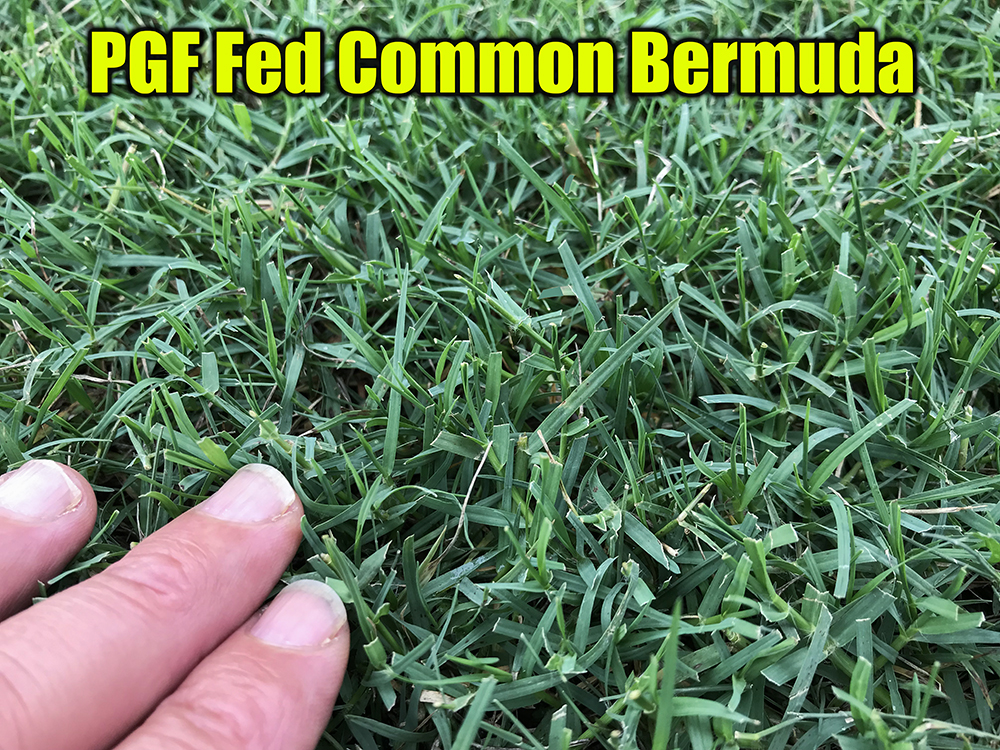
Product Label


